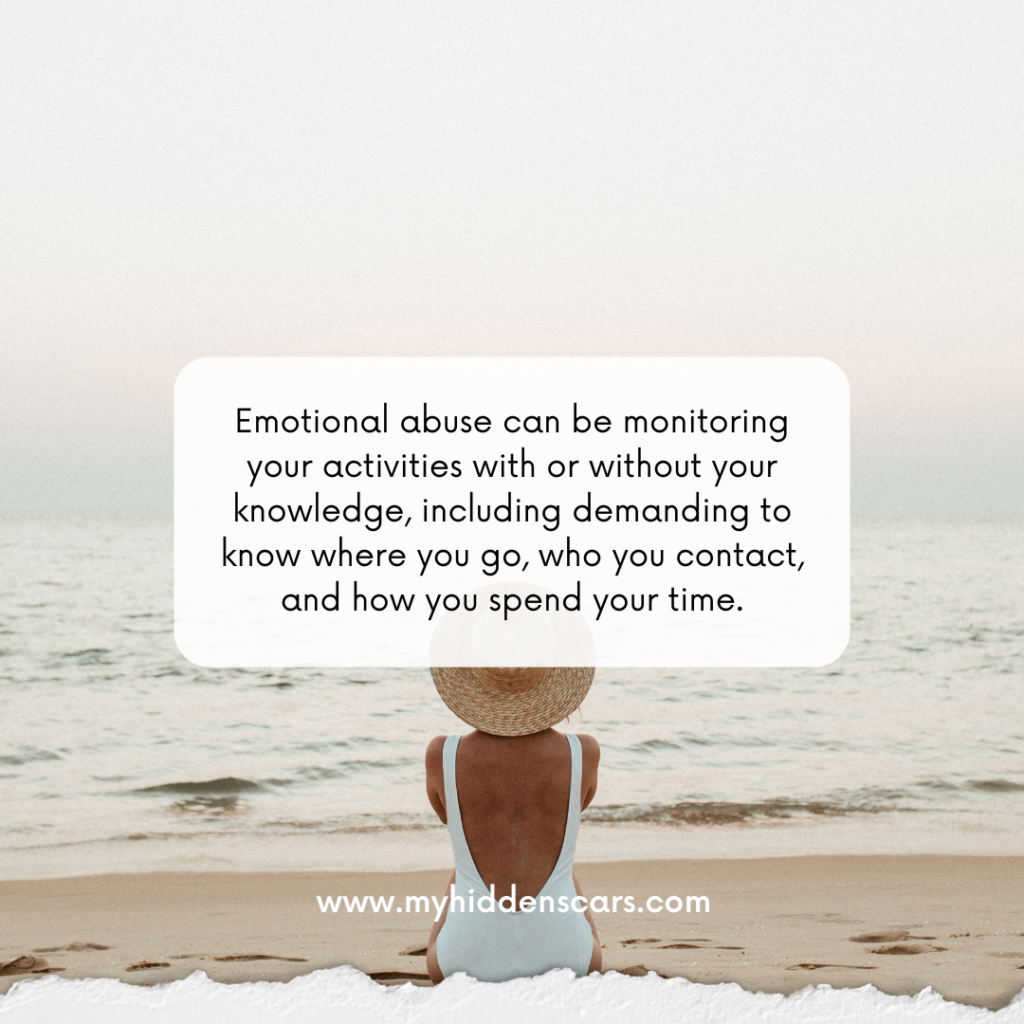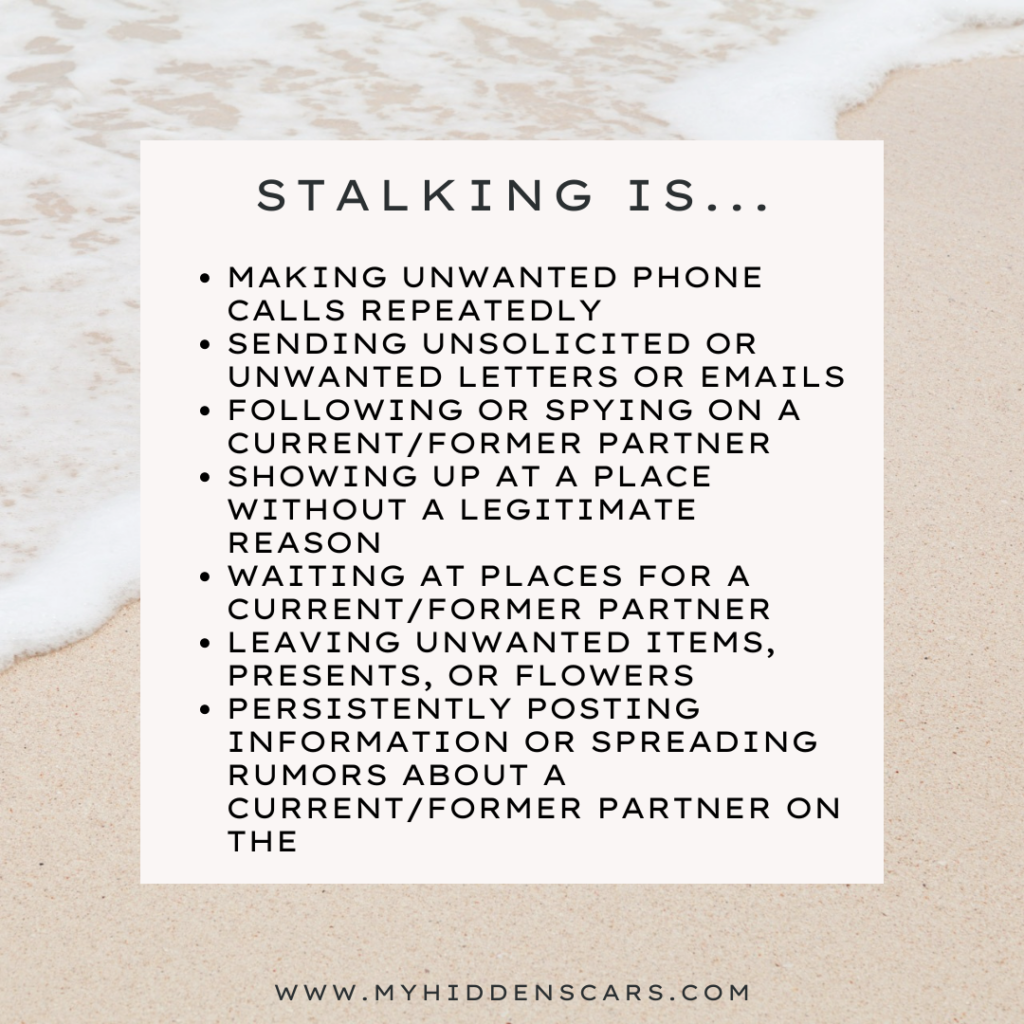Domestic abuse includes various harmful behaviors, ranging from physical violence to emotional manipulation and financial control. One particularly subtle tactic that abusers use is stalking, which creates a sense of fear and insecurity for victims. As a divorce coach and survivor of abuse and stalking by my ex-husband, both during the relationship and after I left, I understand how upsetting and dangerous stalking can be. I also hear from my clients about the different ways their ex stalked them, either while they were together or when they decided to leave the relationship. In this blog post, I want to explore the dynamics of stalking, common methods used by abusers, the impact on victims, recommended safety measures, and sources of support.
What Is Stalking?
Stalking is a pattern of behavior aimed at intimidating, coercing, or controlling someone, resulting in fear, distress, or concern for personal safety. It is a form of harassment that can include repeated unwanted contact, surveillance, or threats. Abusers use stalking to create a sense of constant observation, destroying the victim’s sense of security and independence.

Stalking can take many forms, from physical presence to digital monitoring. Abusers may follow their victims, watch their homes or workplaces, or show up uninvited at social events or locations the victim frequents. In my case, the stalking began while we were married with things that would frustrate me, like knowing where I was when I hadn’t told him, knowing if I had talked with a specific friend, and even that I was on websites that I wouldn’t dare look at when he was home. After we separated, it continued with showing up at stores he usually wouldn’t shop at, parking next to me in different parking lots, and even knowing who and where I was spending my time.
Stalking is a serious crime and often shows a more significant pattern of domestic abuse. It can make it difficult for victims to find peace or rebuild their lives, creating a situation where the victim feels constantly watched and threatened. This behavior can escalate over time, with abusers becoming more aggressive or intrusive as they seek to maintain control.
Abusers often use stalking to isolate their victims, limiting their contact with friends and family. They might use tactics that create a sense of unpredictability, such as showing up unexpectedly or sending threatening messages. This constant sense of surveillance can lead to chronic anxiety, fear, and disruption of the victim’s daily life.
Stalking is a common feature of domestic abuse, and its impact can be severe. Victims may experience emotional and psychological distress, leading to sleep disturbances, social isolation, and physical health issues. The relentless nature of stalking can also lead to depression, loss of self-esteem, and post-traumatic stress disorder (PTSD).
Understanding the behaviors that makeup stalking is important for recognizing the signs and taking appropriate action to protect yourself. If you suspect you’re being stalked, it’s important to document every incident, increase personal security, and seek help from law enforcement and domestic violence organizations. Taking proactive steps can be vital to regaining control and ensuring your safety.

Common Methods of Stalking
Stalking can take many forms, with abusers using a combination of physical, digital, and social tactics to maintain control over their victims. They create an environment where the victim feels constantly watched and harassed. Let’s explore some common methods used by stalkers:
- Physical Surveillance: Abusers often follow their victims, watch their homes or workplaces, or unexpectedly show up at places they frequent. This creates a general sense of being watched, leading to heightened anxiety and fear. My ex-husband would show up uninvited at events I attended, such as parties or other events, which made it difficult for me to feel safe or relaxed in public spaces. This type of surveillance can be highly disruptive, forcing victims to alter their routines and avoid familiar places to reduce the risk of contact.
- Digital Stalking: In today’s digital age, technology plays a big role in stalking. Abusers use various methods to monitor their victims electronically, gaining access to their personal information and communications. Digital stalking can involve installing spyware on devices to track online activity, hacking into email accounts, or using GPS to monitor locations. Social media platforms are common targets for abusers seeking to gather information or intimidate their victims. When I was still married to my ex-husband, he somehow gained access to what I was looking at online. This allowed him to have my online interactions and see things that I was looking at or reading about. He even gained access to my personal banking information without my knowledge. This invasion of privacy adds to the sense of vulnerability and fear.
- Harassment and Unwanted Contact: Stalkers often communicate relentlessly, sending repeated phone calls, texts, emails, or letters. This constant barrage of unwanted contact can be exhausting and overwhelming. Abusers might leave threatening or abusive messages or engage in cyberbullying to intimidate the victim. My ex-husband would send me email after email, and if I didn’t respond right away, he would call me over and over, sometimes dozens of times in a row, leaving aggressive and demanding voicemails. These actions were designed to maintain a sense of control and disrupt my peace of mind.
- Involving Third Parties: Abusers sometimes use friends, family members, or co-workers to gather information or relay messages to the victim. This creates a broader surveillance network, making it harder for victims to avoid detection. By involving third parties, the abuser can maintain control while concealing their direct involvement. In my case, my ex-husband would ask mutual friends about what I was doing and who I was with and use them to deliver messages or pressure me to give him what he wanted.
These typical methods of stalking contribute to an environment of fear, uncertainty, and isolation for victims. Recognizing these tactics is important for taking appropriate safety measures and seeking support. If you experience any of these behaviors, it’s crucial to protect yourself by documenting incidents, increasing personal security, and involving law enforcement. Stalking is a serious crime, and you have the right to seek help and ensure your safety.
Impact on Victims
Stalking can have profound and far-reaching effects on victims, impacting their emotional, psychological, and physical well-being. The relentless fear and uncertainty that come with being stalked can disrupt every aspect of a victim’s life. Here’s an expanded view of the common impacts of stalking:
- Chronic Anxiety and Fear: Stalking often leaves victims in a constant state of anxiety and fear. The sense of being watched or followed can lead to heightened stress and hypervigilance. This chronic anxiety can disrupt everyday activities and create a pervasive sense of danger. In my experience, the fear of encountering my ex-husband in public places caused significant stress and forced me to remain on high alert no matter where I was.
- Disruption of Daily Life: The stress and anxiety caused by stalking can severely disrupt a victim’s daily routines. Victims may need to alter their work schedules, change their routes to and from home, or avoid specific locations to reduce the risk of encountering the stalker. This disruption can affect job performance, educational progress, and personal relationships. I had to change where I parked at certain places, avoid shopping at places I loved, and go different ways to certain places to decrease my chances of seeing my ex-husband, impacting my ability to maintain a routine.
- Sleep Disturbances: The constant fear and anxiety caused by stalking can lead to sleep disturbances. Victims often experience insomnia, nightmares, or other sleep-related issues. The lack of restful sleep can further exacerbate emotional distress and physical health problems. I struggled with sleepless nights, often jolting awake from nightmares, fearing that my ex-husband might appear at any moment, especially when we first separated, and I was living on my own.
- Social Isolation: Stalking can lead to social isolation, as victims may withdraw from friends and family to reduce the risk of being located or harassed. This isolation can result in a loss of support and increased vulnerability. In my case, I stopped attending social gatherings and avoided meeting with friends to prevent my ex-husband from finding out where I was and what I was doing. This isolation can deepen the emotional toll and make it harder for victims to seek help.
- Physical Health Issues: The chronic stress from stalking can take a physical toll on victims. The constant state of alertness and anxiety can lead to headaches, digestive issues, elevated heart rate, and other physical symptoms. Over time, this stress can weaken the immune system and lead to more frequent illness.
- Psychological Impact: The emotional and psychological effects of stalking can be profound, leading to depression, loss of self-esteem, and even post-traumatic stress disorder (PTSD). The relentless nature of stalking can create a sense of hopelessness and helplessness, making it difficult for victims to find a way out. I struggled with severe anxiety and fear, feeling trapped by my ex-husband’s constant presence and harassment.
Understanding the intense effects of stalking on victims is important for providing the proper support and taking appropriate safety measures. If you or someone you know is experiencing these impacts, it’s important to seek professional help and connect with resources that can offer guidance and protection. The emotional, psychological, and physical toll of stalking requires a comprehensive approach to ensure the safety and well-being of victims.

Safety Measures and Support
If you or someone you know is experiencing stalking, it’s important to take action to ensure safety. Stalking can escalate quickly, so having a clear plan and support network is key. Here’s a straightforward guide on safety measures and support resources to help you navigate this challenging situation:
- Document Everything
- Keep detailed records of all stalking incidents.
- Note dates, times, locations, and any communication from the stalker.
- Include details about the nature of the interaction (in-person, text, social media).
- This documentation can be helpful for legal protection and when involving law enforcement.
Enhance Personal Security
- Change Locks: If you suspect the stalker has access to your home, change the locks immediately.
- Install Security Systems: Security cameras, motion detectors, and alarms can act as deterrents and provide evidence if the stalker approaches your property.
- Use Safety Apps: Mobile apps designed for personal safety offer features like emergency alerts, GPS tracking, and automatic recording.
- Vary Daily Routines: Changing daily routines, such as routes to work or school, can make it harder for the stalker to predict your movements.
Limit Information Sharing
- Review Social Media Privacy Settings: Use strict privacy settings to control who can view your posts and personal information.
- Avoid Location-Based Posts: Don’t share your location publicly or use check-in features on social media.
- Be Careful with Personal Details: Limit sharing of personal information, such as your home address, workplace, or daily schedule.
Seek Legal Protection
- Restraining Orders: A restraining order, or protective order, can legally prohibit the stalker from contacting or approaching you.
- File a Police Report: This creates a legal record and can lead to additional protective measures, such as police patrols or increased surveillance.
- Consult with Legal Experts: Legal professionals with experience in domestic abuse cases can advise on your rights and the steps to take to protect yourself.
Involve Law Enforcement
- Report Stalking Incidents: Contact the police with your documented evidence to report stalking incidents.
- Follow Law Enforcement Recommendations: Law enforcement can offer guidance on protective measures and additional steps to ensure safety.
- Request Police Protection: In severe cases, you can request additional police patrols near your home or workplace.
Seek Support from Domestic Violence Organizations
- Divorce Coach: A coach can help you create a personalized safety plan. They have personal experience, so they know and understand how to create a plan.
- Counseling Services: Supportive counseling can help you cope with the emotional impact of stalking.
- Legal Assistance: These organizations often offer legal support, including help with restraining orders and court appearances.
Conclusion
Stalking is a dangerous tactic that abusers use to maintain control over their victims, leading to a cycle of fear, intimidation, and isolation. If you suspect you’re being stalked, it’s important to act quickly and seek help from law enforcement or domestic violence organizations without delay. Your safety and well-being are the top priorities.
To ensure your safety, here are some key steps you can take:
- Seek Legal Protection: Document every incident of stalking and report it to the police. A restraining order or protective order can offer legal recourse against the stalker, helping establish boundaries and providing a level of legal protection.
- Enhance Personal Security: Consider changing locks, installing security systems, and varying your daily routines to make it harder for the stalker to track you. Personal safety apps and other technology can offer added security and peace of mind.
- Limit Information Sharing: Be cautious about what you share online and with others. Review your social media privacy settings, avoid location-based posts, and be careful with personal details that could give the stalker clues about your whereabouts.
- Seek Support from Domestic Violence Organizations: These organizations offer safety planning, counseling, and legal assistance, providing a vital support network during this challenging time.
As someone who has experienced stalking, I know how difficult it can be to navigate this situation. The constant surveillance, unwanted contact, and threats can erode your sense of safety. That’s why taking action is so important. If you’re in immediate danger, call emergency services right away. Remember, you don’t have to face this alone. There are people and resources dedicated to helping you reclaim your safety and well-being.
You have the right to live without fear. By addressing stalking early and seeking the proper support, you can break free from the cycle of control and intimidation. Don’t hesitate to reach out and get the support you need.



This blog is a powerful and insightful guide on stalking in domestic abuse. It raises crucial awareness and offers valuable information to support victims. Thank you for shedding light on this important issue!
Thank you for reading! I truly is important as many don’t realize how domestic abuse is more than just being physically hurt.
Thank you so much for this. It really means a lot to know the post resonated with you. Stalking in abusive relationships is something so many people deal with but don’t always recognize or feel safe talking about. I’m really glad it helped shine a light on something that often gets overlooked. You’re not alone—and I’m so grateful you’re here.
If you ever want to read more or are looking for support, I share a lot more over on the blog and social media. I’m always trying to make sure no one feels alone in this.
[…] What resonated most with me was how raw and honest Pip’s experiences felt, from the dismissals she faced to the lengths she went to protect herself. Her persistence and courage highlight the importance of believing in survivors and advocating for systemic change. It also reminded me of how closely stalking is tied to control in abusive relationships. […]
Yes—exactly. That raw honesty in Pip’s story hit me too. The way she was dismissed over and over felt so real, and I think it mirrors what so many survivors go through. I’m really glad that part stood out to you. Stalking is so often about control, and it’s something we don’t talk about enough. Thank you so much for sharing this.
If you ever want to dive deeper or are looking for more support—whether it’s for yourself or someone you care about—I’ve shared more on the blog and social media. I’m always trying to create space where survivors feel seen and supported.
[…] is rarely about admiration or harmless persistence—it’s one of the key signs of stalking and dating abuse, rooted in power and control. In relationships, this can look like one partner […]